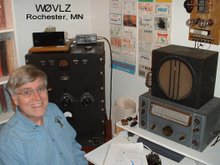 independent vertical antenna (or C-Pole). See here and April 2004 QST, page 37, for more information. After trimming it a little it measures 1:1 at 14.060 MHz rising to 2.5:1 at 14.35MHz and 1.2:1 at 14.0MHz.
independent vertical antenna (or C-Pole). See here and April 2004 QST, page 37, for more information. After trimming it a little it measures 1:1 at 14.060 MHz rising to 2.5:1 at 14.35MHz and 1.2:1 at 14.0MHz.I found the choke balun to be key to making this antenna work. With no choke the SWR was over 14:1 at 14.060MHz and with a 10 ferrite bead choke the SWR was still 2.8:1 at 14.060MHz. What I'm using now is 15 turns of RG8X single
 layer wound on a 4" plastic coffee can.
layer wound on a 4" plastic coffee can.This antenna is about 18' tall, self supporting without guys and has only a 4' x 5' footprint. It breaks down to a bundle 5' long. Physically it looks like a tall skinny goal post. Add a birdie and two racquets and it should fit well into a typical camping weekend.
View a video of me setting up this antenna at
https://youtu.be/nYn-GnwcSoE
Today I made several nice contacts using my K1 at 5 watts a
 nd this antenna including W8CQU in Ohio (599), WA3SLN in Pennsylvania (449), W0WCA in Colorado (449), KI0II in Colorado (549) and N4ESS in Florida (579).
nd this antenna including W8CQU in Ohio (599), WA3SLN in Pennsylvania (449), W0WCA in Colorado (449), KI0II in Colorado (549) and N4ESS in Florida (579).This antenna is going with us when we go camping this summer. Thank you KF2YN.
Update: On June 23 I worked EA6UN on the Balearic Islands off the coast of Spain in the western Mediterranean Sea. That's over 4600 miles on my five watts and this antenna. I found Jurek calling CQ on 14.050 MHz with no responses. He came right back to me and gave a 579 report.

2 comments:
Pretty cool Niel! I have a couple Black Widow 16.5 ft poles ordered and on the way so I can build the single C Pole based on your plans and recommendation on my blog. Wonder if you could share a bit more construction detail with me?
Did you use the Black Widow crappie poles? Is the 3/4" PVC the right size for the uprights? The picture isn't real clear on how you mounted the crappie poles to the uprights? Also wonder how high the bottom of the antenna is above ground?
Thanks for the info you share. I love it!
72,
Kelly K4UPG http://k4upg.com
Kelly,
Thanks for the feedback on my Crappie Pole C-Pole. I've found it to be great antenna. I love it also! Normally for the hiking or spur of the moment trips I use a 67' (or 45') endfed wire. It all packs in the lunch bag with my K1. But if I plan ahead and have the space I use the C-Pole.
This all started with my trying to build a W6ZO Portable Delta Loop. I found the crappie poles really didn't work well with W6ZO's antenna when using what I thought was reasonable sized wire. The crappie poles weren't stiff enough...so I started building a series of crappie pole antennas until I ended up with the Crappie Pole C-Pole. See my website at http://www.prismnet.com/~nielw/wa5vlz.htm for more information about my three Crappie Pole Antennas for 20 Meters.
I used crappie poles from Cabelas that, when the end caps are removed, will slip over 3/4" PVC pipe. I found I had to sand the PVC down a very little but they did fit.
According to KF2YN the bottom of the loop needs to be at least a foot off the ground....ground loses go up as you get closer to the ground. The bottom of mine is 3'-4' off the ground.
To make the antenna easy to stand up, the two outriggers are attached to the 5' base by one wingnut and bolt each. When laying on the ground getting put together the outriggers are in line with the base and the whole thing lies pretty flat. Once the antenna is stood up the outriggers can be swung out and the wingnuts tightened down.
One more thing, don't run the wire through to crappie pole tip loops. Use something like a fishing swivel or a large paper clip tied to the wire in the right spots for the upper two corners. Clip the wire to the crappie pole loops rather than run the wire through the loops.
One other thing I stumbled upon was using electrical conduit brackets at the two bottom corners of the loop. Add an eyebolt to run the wire through and a bolt/wingnut to tighten them down and they can be positioned how ever is needed to tighten the loop.
tnx es 73,
Niel
Post a Comment